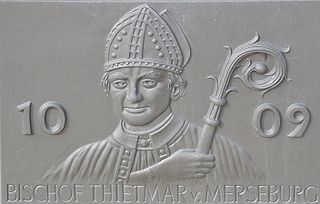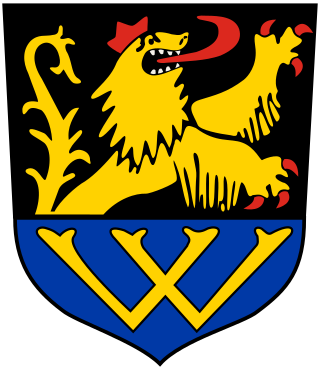Related Research Articles

The Northern March or North March was created out of the division of the vast Marca Geronis in 965. It initially comprised the northern third of the Marca and was part of the territorial organisation of areas conquered from the Wends. A Lutician rebellion in 983 reversed German control over the region until the establishment of the March of Brandenburg by Albert the Bear in the 12th century.

Thietmar, Prince-Bishop of Merseburg from 1009 until his death, was an important chronicler recording the reigns of German kings and Holy Roman Emperors of the Ottonian (Saxon) dynasty. Two of Thietmar's great-grandfathers, both referred to as Liuthar, were the Saxon nobles Lothar II, Count of Stade, and Lothar I, Count of Walbeck. They were both killed fighting the Slavs at the Battle of Lenzen.

Eckard I was Margrave of Meissen from 985 until his death. He was the first margrave of the Ekkehardinger family that ruled over Meissen until the extinction of the line in 1046.
Dietrichof Haldensleben was a count in the Schwabengau, later also in the Nordthüringgau and the Derlingau, who was the first Margrave of the Northern March from 965 until the Great Slav Rising of 983. He also bore the title of a dux (duke) in contemporary sources.

OdoI was margrave in the Saxon Eastern March of the Holy Roman Empire from 965 until his death.
Lothair I was Margrave of the Nordmark from about 983 until his death. He was also a member of Saxon nobility as Count of Derlingau and of Nordthüringgau.
Gunther was the Margrave of Merseburg from 965 until his death, upon which the march of Merseburg was united to that of Meissen.

The Counts of Stade were members of the Saxony nobility beginning in the 10th century. Stade had developed since the 8th century as a principal center of trade and communications. The Counts of Stade created their domain between the lower Elbe and Weser rivers. They extended their power northwards with the acquisition of Dithmarschen in the 11th century. They became the Margraves of the Nordmark in 1056. There is also a close political and familial relationship between the Counts of Stade and the Counts of Walbeck. The Northern March was replaced with the March of Brandenburg by Albert the Bear in the 12th century. The family of Counts of Stade is referred to as the House of Udonids.
Henry I the Bald was Count of Stade. He was son of Lothar II, Count of Stade, and Swanhild of Saxony. Henry is recorded as a cousin of Otto I, Holy Roman Emperor, but their exact relationship remains a mystery. Henry was also appointed Count of Heilangau, the ancient capital of Stade, in 959.

The Counts of Walbeck ruled a medieval territory with its capital Walbeck northeast of Helmstedt in the present town Oebisfelde-Weferlingen in Saxony-Anhalt. The foundation of the Archbishopric of Magdeburg established the region as firmly in the oversight of Otto the Great, Holy Roman Emperor. The first Count of Walbeck, Lothar I, was great-grandfather of Thietmar, Prince-Bishop of Merseburg, chronicler of the Ottonian dynasty of Germany and the Holy Roman Empire. Two of Thietmar’s great-grandfathers, both named Lothar, were killed in the Battle of Lenzen, pitting the forces of Henry the Fowler against the Slavs. The early Margraves of the Nordmark were descended from the House of Walbeck.
Lothair Udo I, Count of Stade, son of Henry I the Bald, Count of Stade, and his wife Judith von der Wetterau, granddaughter of Gebhard, Duke of Lorraine. Lothair is frequently confused with his nephew Lothair Udo II, son of his brother Siegfried II, who was Margrave of Nordmark as Lothair Udo I.
Siegfried II, Count of Stade, was the youngest son of Henry I the Bald, Count of Stade, and his wife Judith von der Wetterau, granddaughter of Gebhard, Duke of Lorraine. He succeeded his brother, Henry as Count of Slade in 1016.
Lothar II the Elder, Count of Walbeck, son of Lothar I, Count of Walbeck.
Lothair Udo I, Margrave of Nordmark and Count of Stade, son of Siegfried II, Count of Stade, and Adela of Rhienfelden, daughter of Gero, Count of Alsleben. Lothair was the first of the House of Udonids to serve as margrave.
Siegfried I the Elder, Count of Walbeck and Möckerngau, son of Lothar II the Old, Count of Walbeck, and Mathilde von Arneburg.
Henry, Count of Walbeck, son of Siegfried I the Older, Count of Walbeck, and Kunigunde von Stade, daughter of Henry I the Bald, Count of Stade. Virtually all that is known about Henry was provided in the chronicle of his brother Thietmar of Merseburg.
Friedrick, Count of Walbeck and Viscount (Burggraf) of Magdeburg, son of Siegfried I the Older, Count of Walbeck, and Kunigunde von Stade daughter of Henry I the Bald, Count of Stade. He was brother to Thietmar of Merseburg, whose Chronicon was the main source of information on him, and his predecessor Henry, Count of Walbeck.
Conrad (1018–1073), Count of Walbeck and Viscount (Burggraf) of Magdeburg, son of Friedrick, Count of Walbeck, and Thietburga. There is little known about Conrad's reign.
The Battle of Pritzlawa (Prinzlowa) in 1056 took place near present Quitzöbel between the Saxons and the Slavic Liutizen. The battle was a disaster for the Saxons, killing many knights and their leader William, Margrave of the Nordmark.
Gerhard of the Moselle, Count of Metz and possibly of Alsace, was a Lotharingian noble active in the early 11th century. He was a key figure within an alliance of Lotharingian nobles who were seen as opponents of Henry II, Holy Roman Emperor. This also put him in constant conflict with the king's loyal representatives in Lotharingia, his relatives in the family known to historians as the House of Ardenne–Verdun. Henry II was Gerhard's brother-in-law, as they had both married daughters of Count Sigfried, the ancestor of the counts of Luxembourg. He was also in the Ardenne dynasty, though his family came to be opposed to his Verdun cousins.
References
- ↑ Jackman, Donald C. (1997). Criticism and Critique: Sidelights on the Konradiner. University of Michigan: Unit for Prosopographical Research.
- ↑ Warner, David A. (2001). Ottonian Germany: The Chronicon of Thietmar of Merseburg. Manchester: Manchester University Press. pp. 133–134.
- ↑ Janin, Hunt (2004). Medieval Justice: Cases and Laws in France, England, and Germany : 500-1500. McFarland.